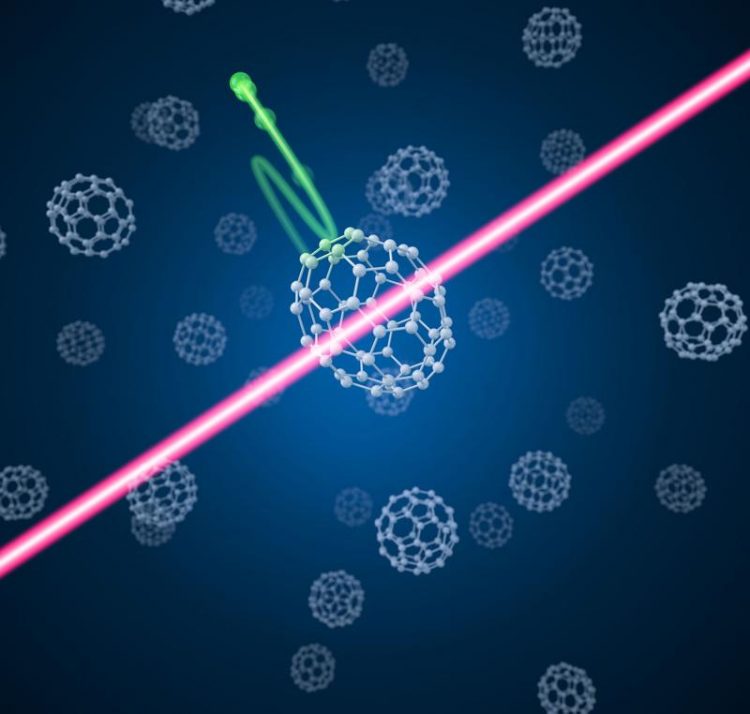Transformation through Light

An infrared laser pulse hits a carbon macromolecule. This induces a structural transformation of the molecule and releases an electron into the environment. Alexander Gelin
When carbon molecules C₆₀ are exposed to an intense infrared light, they change their ball-like structure to a more elongated version. This has now been observed via laser-induced electron diffraction by laser physicists from the Max Planck Institute of Quantum Optics (MPQ) and the Ludwig-Maximilians-Universität Munich (LMU) in collaboration with colleagues from the United States and Japan.
C₆₀ is an extremely well-studied carbon molecule, which consists of 60 carbon atoms and whose structure looks like a ball. The macromolecule is also known as buckminsterfullerene (or buckyball), a name given as a tribute to the architect Richard Buckminster Fuller, who has constructed buildings with similar shapes.
The laser physicists have now irradiated such buckyballs with infrared femtosecond laser pulses (one femtosecond is a millionth of a billionth of a second). Under the influence of the intense light the form of the macromolecules was changed from round to elongated.
The physicists were able to observe this phenomenon by using the following trick: at its maximum strength the infrared pulse triggered the release of an electron from the molecule.
Through the oscillations in the electromagnetic field of the light, the electron was first accelerated away from and then back toward the molecule (see figure) all within the timespan of a few femtoseconds.
Finally, the electron scattered off the molecule and left it completely. Images of these diffracted electrons carried an imprint of the deformed structure of the molecule.
Fullerenes, the discovery of which was honored with the Nobel Prize in chemistry in 1996, are stable, biocompatible, and exhibit remarkable physical, chemical, and electronic properties.
“The deeper understanding of the interaction of fullerenes with ultrashort, intense light can result in new applications in ultrafast, light-controlled electronics, which could be many order of magnitude faster than conventional electronics,” explains Matthias Kling, professor at the LMU Munich and head of the group in the Laboratory for Attoseconds (LAP) team.
Laser-induced electron diffraction (LIED), the structural imaging method, has so far only been demonstrated on smaller systems, and was used on a macromolecule for the first time. “The imaging of the deformation of the buckyball, which only lasts a few tens of femtoseconds, is an important advance in laser-induced electron diffraction. It paves the way toward recording molecular movies of complex (bio)molecules,” adds Kling.
As a result, the laser physicists are planning to record movies over a longer period to investigate the dynamics of fullerenes in more detail. (TN)
Prof. Dr. Matthias Kling
Laboratory for Attosecond Physics
Max Planck Institute of Quantum Optics
Hans-Kopfermann-Str. 1, 85748 Garching
Phone: +49 89 32905 234
Email: matthias.kling@mpq.mpg.de
Harald Fuest, Yu Hang Lai, Cosmin I. Blaga, Kazuma Suzuki, Junliang Xu, Philipp Rupp, Hui Li, Pawel Wnuk, Pierre Agostini, Kaoru Yamazaki, Manabu Kanno, Hirohiko Kono, Matthias F. Kling, and Louis F. DiMauro;
Diffractive Imaging of C60 Structural Deformations Induced by Intense Femtosecond Midinfrared Laser Fields
Phys. Rev. Lett. 122, 053002 – 6 February 2019
DOI: 10.1103/PhysRevLett.122.053002
Media Contact
All latest news from the category: Physics and Astronomy
This area deals with the fundamental laws and building blocks of nature and how they interact, the properties and the behavior of matter, and research into space and time and their structures.
innovations-report provides in-depth reports and articles on subjects such as astrophysics, laser technologies, nuclear, quantum, particle and solid-state physics, nanotechnologies, planetary research and findings (Mars, Venus) and developments related to the Hubble Telescope.
Newest articles

Properties of new materials for microchips
… can now be measured well. Reseachers of Delft University of Technology demonstrated measuring performance properties of ultrathin silicon membranes. Making ever smaller and more powerful chips requires new ultrathin…

Floating solar’s potential
… to support sustainable development by addressing climate, water, and energy goals holistically. A new study published this week in Nature Energy raises the potential for floating solar photovoltaics (FPV)…

Skyrmions move at record speeds
… a step towards the computing of the future. An international research team led by scientists from the CNRS1 has discovered that the magnetic nanobubbles2 known as skyrmions can be…





















